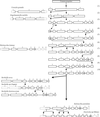Evolution of IESs and scrambling in the actin I gene in hypotrichous ciliates
- PMID: 11742064
- PMCID: PMC64990
- DOI: 10.1073/pnas.011578598
Evolution of IESs and scrambling in the actin I gene in hypotrichous ciliates
Abstract
Germ-line (micronuclear) genes in hypotrichous ciliates are interrupted by numerous, short, noncoding, AT-rich segments called internal eliminated segments, or IESs. IESs divide a gene into macronuclear destined segments, or MDSs. IESs are excised from micronuclear genes, and the MDSs are spliced when a micronuclear genome is processed into a macronuclear genome after cell mating. In the micronuclear version of the actin I gene intramolecular recombination between IESs during evolution has put MDSs into a scrambled disorder in some but not all hypotrichs. Studies using rDNA sequences to define phylogenetic relationships among eight hypotrichs suggests that evolution of the micronuclear actin I gene proceeds by successive addition of IESs in earlier diverging species, without MDS scrambling. Continued addition of IESs and recombination among IESs in later diverging species produced actin I genes with scrambled MDSs. Subsequent to MDS scrambling, additional IESs were inserted into the more recently evolved species. Thus, IES insertions and gene scrambling occur in a progressive manner during species evolution to produce micronuclear actin I genes of increasing structural complexity.
Figures



References
Publication types
MeSH terms
Substances
Associated data
- Actions
- Actions
- Actions
- Actions
- Actions
- Actions
Grants and funding
LinkOut - more resources
Full Text Sources
Research Materials
Miscellaneous

